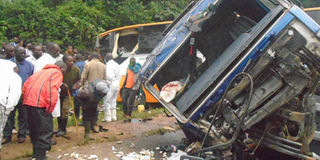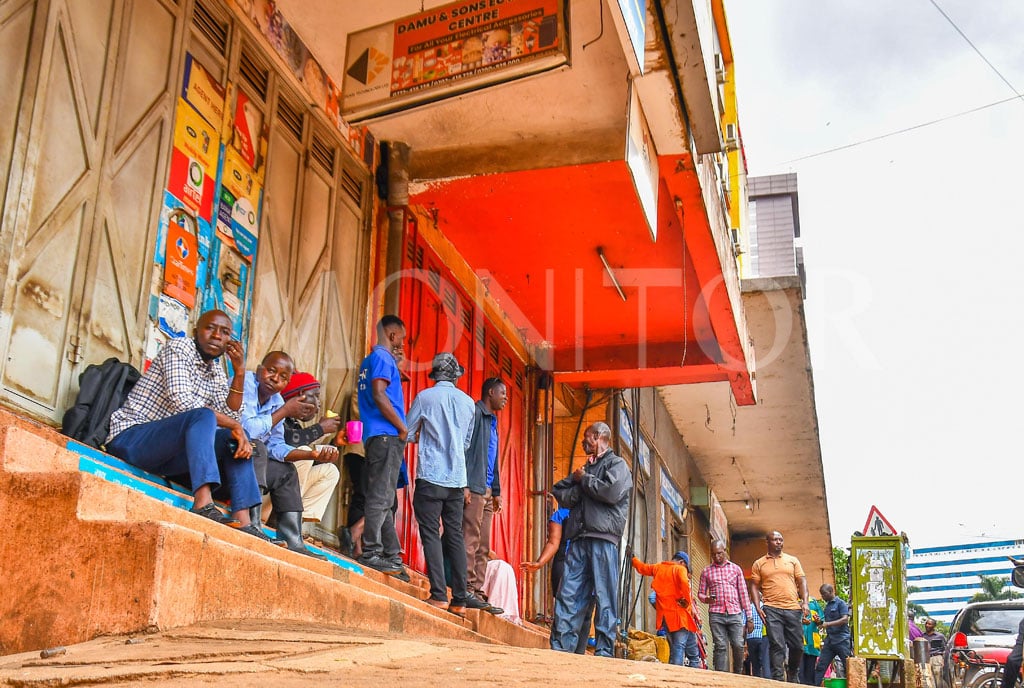Kampala-Masaka highway: cursed or flawed?

Onlookers check out the carnage after an accident. FILE Photo
What you need to know:
The Kampala-Masaka highway has been labelled a deathtrap by some due to the numerous accidents there. Didas Kisembo explores the subject
The most dangerous road in the world is the North Yungas Road in Bolivia. In 2006, statistics showed that between 200 and 300 travellers were killed yearly on the road.
Juxtapose that with the statistics from Hellen Nnajjuma’s 2013 thesis on road traffic accidents in Uganda which revealed that there were 101 fatal accidents, 278 serious accidents and 231 accidents along Masaka-Kampala highway in 2010 and it becomes apparent why the Ugandan road is being labelled a ‘death trap’.
In the last month and a half alone, the Kampala-Masaka highway has claimed several lives, leaving several others injured in a series of accidents that started on the morning of July 1, when at least three people died and eight others sustained injuries. For years now, the highway – dubbed a “killer road” – continues to, sadly, claim lives.
This predicament has at times even got stakeholders tangled in the blame game. Police have often pointed fingers at the Uganda National Roads Authority for doing shoddy work on the road attesting to its surface being slippery, while UNRA dismissed the claims as ‘escapist talk’. Last year, in an NTV broadcast, UNRA officials went further to fault motorists for the accidents that had occurred.
As if that were not enough, another school of thought albeit an unconventional one propped up the theory that the road is cursed. Those who subscribe to this theory believe the people killed on the road are a form of sacrifice to some an unknown spirit. This remains hearsay but it does not diminish the fact that the number of accidents on the road is worrying.
So why have the accidents persisted? Is it cursed, flawed or is it driver/mechanical error?
An issue of topography
Its topography, which features several blind corners and sharply meandering bends with some narrow parts of the road, is among the reasons that have been advanced to attest to its deadliness
In her findings, some places such as Mpugwe, Kkingo, Mukoko and Bisanje along the highway, were identified as highly prevalent with road accidents characteristically narrow, has potholes, and dangerous blind spots.
While UNRA asserts that it is due to reckless driving or mechanical errors, a closer look at some of the cases unearths the reality that it may be a mix of all the above mentioned factors.
Too much death
In October 2011, a Masaka road accident claimed one life, and left 14 others injured after a pickup truck on which they were travelling overturned.
Onlookers at the scene recounted how the incident, which happened around Kyetume along Masaka-Mbarara highway, was a result of over speeding and the driver losing control when he attempted to over-take a speeding bus.
The following year, within a month, three people lost their lives and 14 others sustained serious injuries when a Kampala-bound Jussy Bus collided with a government double cabin pick-up truck.
In December 2014, three people perished in an accident on the highway. The accident occurred at Kyakumpi when a Subaru car that was travelling from Nyendo through Kyakumpi road to Masaka town collided with Fuso truck.
Eye witnesses noted that the Subaru driver rammed into a Fuso truck that was joining the main road from Nyendo.
Last month, three people died and seven others were seriously injured in an accident involving seven vehicles at Katende in Mpigi District on Masaka Road. Police attributed the accident to speeding and reckless driving by the lorry driver as well as the poor condition of the road.
“It was raining and the road was so slippery. The taxi was knocked by two vehicles; a speeding lorry that was carrying matooke from Masaka and a Canter carrying milk cans,” Mr Philip Mukasa, then Katonga police regional spokesperson, said in an interview with this paper at the time.
However, onlookers at the scene, according to some media reports, blamed the misfortune on satanic forces that haunt the road!
This year, five people died on spot and several others escaped with injuries in an accident along the highway in Mpigi District. The accident involved three vehicles; a commuter taxi, a trailer and a Toyota Noah.
Witnesses recounted how an overloaded commuter taxi was heading to Masaka from Kampala but the journey was cut short about 30 kilometers away at Kammengo when it collided with the trailer.
‘Drivers to blame’

Police carry out a road a safety campaign on Masaka Road last month.
Alan Musinguzi, a construction engineer, argues that there is nothing wrong with the road in terms of the quality of surface except for inadequacy in marking.
“The road is okay except for the issue that there are many blind spots and black spots along the route and the worst part is these are not marked to guide the driver,” he notes.
“Those drivers that find it slippery may have an issue with their tires. May be they are worn out. That is what would happen when driving on a smooth surface.”
Musinguzi dispels any talk of the road being cursed or haunted, rather preferring to accept the more logical angle to the frequent occurrence of accidents.
“I once read something on social media that there are thugs who pour oil on the road at certain points hence rendering it slippery. That their main objective is to rob the victims once an accident has occurred,” he narrates.
Roadworks so far
From 2010 to 2011, UNRA carried out a couple of repairs on the road to fix some of the sections that were in a bad state, also announcing in 2012 that it would be expanding the 63-kilometre stretch on the highway.
“We want to widen the Kampala-Masaka road, especially on slopes, to allow heavy trucks climbing the slopes to have their own lanes for smooth flow of traffic and also removing sharp bends that have been the cause of road accidents when vehicles are negotiating them,” the UNRA spokesman, Dan Alinange, noted.
Fast forward to 2015, information from the UNRA website indicates that the reconstruction of Kampala-Masaka road is still ongoing.
Physical works involve reconstruction and widening of the entire road to 11m carriageway road including shoulders.
Works will also include realigning of bends, constructing of climbing lanes, parking lanes, bus bays and junctions, and installation of new road signs and marking. Physical works started at the end of April 2009.
So far, phase II which starts from Busega and is funded by the Government of Uganda has 96 per cent of works completed.
For now, it seems most accounts seem to back the theory of driver error as the main cause of accidents along the route. So if you are planning to take a drive along the highway, then please drive safe.
READ ON




